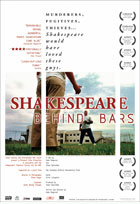
Shakespeare Behind Bars 2005
Distributed by International Film Circuit, 301 East 22nd Street, New York, NY 10010
Produced by Hank Rogerson and Jilann Spitmiller
Directed by Hank Rogerson and Jilann Spitmiller
DVD, color, 93 min.
Adult
Theater, Rehabilitation, Criminal Justice
Date Entered: 05/01/2006
Reviewed by Dr. Beth A. Kattelman, Columbus Metropolitan Library, Columbus, OHThis documentary follows a group of inmates at Kentucky’s Luther Luckett Correctional Complex who take part in a production of Shakespeare’s The Tempest. It follows the entire process of casting and rehearsals, and concludes with scenes from a performance given for family and friends. The prison production is supervised by volunteer director, Curt Tofteland who has been involved with the Shakespeare project for a number of years. Tofteland has a good knack for working with the inmates in an honest and firm manner, encouraging them to explore their own feelings and emotions in order to awaken the inner lives of their characters. As the men learn Shakespeare’s text, they also learn some things about themselves. The theme of forgiveness in The Tempest has a special resonance with this population, and several scenes involve the inmates sharing their thoughts on incarceration and how society has dealt with them. Through the process of exploring Shakespeare’s text and its underlying themes and relationships, the men form a special bond with their fellow players and with the director who helps to bring them together. One particularly interesting aspect of the documentary is the segments devoted to inmates who have been chosen to play the female roles. Portraying a woman proves a special challenge for these men, who spend most of their days holding up a tough veneer in order to survive in prison.
Throughout the film, the inmates offer reflections upon their lives and the circumstances that brought them to a life behind bars. The filmmakers wisely let the audience get to know the men as individuals before revealing the horrific nature of their crimes, thus, the film builds empathy for its subjects. The inmates tell their own stories without comment by the filmmakers and no background evidence related to their crimes is presented, so it is up to the audience to judge the truthfulness of their claims. This “fly-on-the-wall” technique is useful in allowing the audience to peek in on the prisoners’ world.
While the absence of commentary works well in much of the film, it would have been helpful if the filmmakers would have provided more background on the prison’s Shakespeare program itself. While the audience can glean some information from the interviews with the director and prison officials, more context and information of previous successes and challenges would help to round out the film and make it even more useful to those looking to study the long-term effects of these types of programs. Even so, the documentary would be a good investment for law libraries and academic libraries associated with universities offering degrees in law and/or criminal justice. The film includes rough language and disturbing descriptions of crimes. It is recommended for mature audiences.
Awards
- Special Jury Prize, Independent Film Festival of Boston
- Director’s Choice Award, Bluegrass Film Festival
- Best of Show, Bend Film Festival
- Audience Award, Orinda Film Festival
- Best Feature Film, River’s Edge Film Festival
- Crystal Heart Winner, Heartland Film Festival
- Best Documentary, Bethel Film Festival
- Best Documentary, Ojai Film Festival